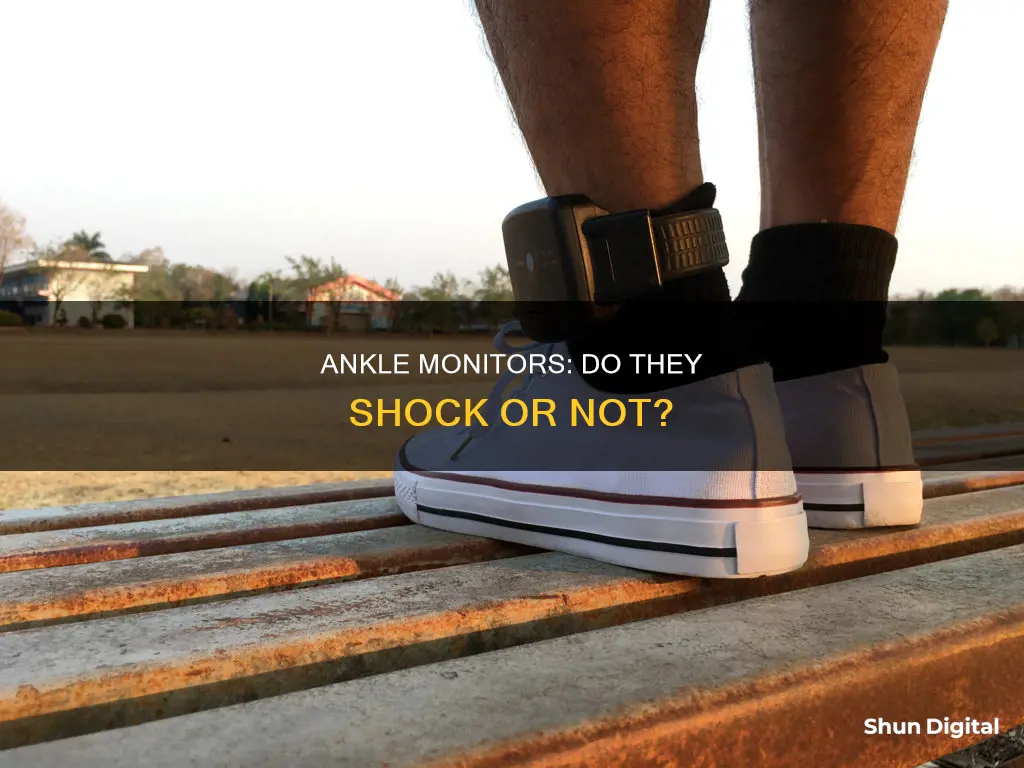
Ankle monitors are electronic devices used to track an individual's location and ensure they comply with the terms of their release. While they are often seen as a more humane alternative to incarceration, ankle monitors have been described as a form of digital shackles that restrict the liberty of the wearer. In addition to concerns about the cost and effectiveness of ankle monitors, there have also been reports of medical complications, including electric shocks, cuts, bruises, and impaired circulation. As the use of ankle monitors continues to rise, particularly in the American criminal justice system, it is important to consider the potential consequences and impacts on the wearers.
| Characteristics | Values |
|---|---|
| Purpose | Surveillance, tracking, monitoring |
| Users | People on bail or probation, immigrants, sex offenders, violent offenders, domestic violence offenders |
| Technology | GPS, radio frequency, A-GPS, GLONASS satellite system |
| Features | Waterproof, long-lasting battery, zone storage, user-friendly software, victim notification mobile app |
| Effects | Cruel, unexpected, a form of incarceration, financial burden, medical complications (cuts, bruises, impaired circulation, electric shocks, hair loss, headaches, difficulty breathing) |
What You'll Learn
- Ankle monitors can be used for bail, probation, parole, and immigration purposes
- They can cause medical complications like cuts, bruises, and impaired circulation
- Ankle monitors can be expensive, costing up to $30 per day
- They can be used to track sex offenders, violent offenders, and those on house arrest
- Ankle monitors can be paired with smartphones to enhance tracking capabilities

Ankle monitors can be used for bail, probation, parole, and immigration purposes
Ankle monitors are used as a form of surveillance, often to track the location of individuals and ensure they are complying with the terms of their release. They are commonly used for bail, probation, and parole purposes, but can also be used in immigration cases and in healthcare settings.
Bail
Ankle monitors can be used as a condition of bail to allow individuals to remain free while awaiting trial, provided they meet certain conditions set by the court. This is often seen as a less restrictive alternative to pre-trial detention. The court may require an individual to wear an ankle monitor if they are considered a flight risk or a danger to the community. By agreeing to wear an ankle monitor, individuals can also increase their chances of getting a lower bail amount or even no bail at all. However, failure to wear an ankle monitor as mandated by the court could result in higher bail or jail time.
Probation and Parole
Ankle monitors are frequently used during probation and parole to monitor an individual's location and ensure they are adhering to the terms of their release. This includes complying with any curfews, sticking to specific areas, avoiding certain people, or refraining from alcohol consumption. For example, in cases of domestic violence, ankle monitors can be used to ensure the offender maintains a required distance from the victim. A violation of the terms of probation or parole, such as reoffending or removing the ankle monitor, can result in additional penalties, including jail time.
Immigration
In some instances, individuals awaiting court dates for immigration proceedings may be required to wear ankle monitors. This allows authorities to track their location and ensure they do not abscond. Private immigration bond programs may also subject individuals to electronic monitoring, even when it is not required by immigration authorities.
While ankle monitors are touted as a way to keep individuals out of jail and with their families, they have been criticised for creating new forms of incarceration and causing financial, medical, and psychological hardships.
Karaoke Monitor Size: Choosing the Best Display for Your Needs
You may want to see also

They can cause medical complications like cuts, bruises, and impaired circulation
Ankle monitors can cause a range of medical complications, including cuts, bruises, and impaired circulation. The weight and bulkiness of the device can cause discomfort and pain, leading to difficulty in walking and standing. This was evident in the experience of M.M., a full-time student and employee, who had to wear an ankle monitor for 63 days. He described how the device became heavier and more painful throughout the day, causing him to bleed and impairing his ability to walk.
The constant pressure and restriction of movement caused by ankle monitors can lead to cuts and bruises. In some cases, individuals may try to adjust the device or hide it under clothing, which can further increase the risk of injury. The device's tightness can restrict blood flow, causing impaired circulation and numbness in the feet. This was the case for M.M., who experienced numbness in his feet and had to push the device down to alleviate the pain and allow for blood circulation.
The discomfort and pain associated with ankle monitors can significantly impact an individual's daily life and activities. M.M. described how he had to alternate between three pairs of pants to accommodate the device and avoid public humiliation. He was unable to wear shorts or other comfortable clothing, impacting his ability to visit the beach or engage in outdoor activities. The constant weight and pressure of the device can also cause bruising and discomfort, further impacting mobility and quality of life.
In addition to physical complications, ankle monitors can also take a mental toll on wearers. The constant presence of the device can serve as a reminder of past mistakes and restrict freedom and independence. M.M. described how the ankle monitor was his "greatest source of pain," both physically and metaphorically, as it constantly reminded him of his past and limited his ability to live a normal life. The financial burden of paying for the device, as in the case of Willard Birts, can also contribute to stress and anxiety, impacting overall well-being.
To conclude, ankle monitors can indeed cause medical complications such as cuts, bruises, and impaired circulation. The physical restrictions and discomfort associated with these devices can significantly impact the daily lives and well-being of those who wear them. The constant pressure, weight, and bulkiness of ankle monitors can lead to pain, bruising, and restricted blood flow. Additionally, the mental toll of being constantly reminded of past mistakes and the loss of freedom can also contribute to the overall negative impact of ankle monitors.
Monitor Refresh Rates: Finding Your Hertz
You may want to see also

Ankle monitors can be expensive, costing up to $30 per day
Ankle monitors can be expensive, often costing the wearer up to $30 per day. This cost is in addition to any other fines or fees associated with their case, and the individual's ability to pay is rarely considered when determining the fee. In some cases, private companies provide the surveillance technology, profiting from the wearer's fees.
The daily cost of an ankle monitor can vary depending on the county and the offence, ranging from $10 to $35 per day. This expense can be a significant burden, especially for those from marginalised communities, as it can lead to homelessness and financial instability. For example, Willard Birts, a 60-year-old man from Oakland, had to pay $30 per day for his ankle monitor, amounting to $840 per month. This left him unable to afford rent and forced him to live in his car.
The high cost of ankle monitors has sparked debates about the role of private companies in the criminal justice system and the potential conflict between profit-driven decisions and individuals' freedoms. Some argue that the money spent on electronic surveillance could be better invested in mental health services, substance abuse treatment, and employment support to address the root causes of criminal behaviour.
While ankle monitors can be costly, individuals do have the option to refuse them and serve their sentence in jail instead. However, this option may not always be feasible, especially for those who want to maintain their employment or family responsibilities. Ultimately, the decision to wear an ankle monitor and incur the associated costs is a complex one, balancing the desire for freedom and the ability to pay.
Removing AC Monitor Cover: A Step-by-Step Guide
You may want to see also

They can be used to track sex offenders, violent offenders, and those on house arrest
Ankle monitors are often used as a form of surveillance to track the location of individuals and ensure they are complying with the terms of their release. This includes sex offenders, violent offenders, and those on house arrest.
For sex offenders, ankle monitors are seen as a way to better track these individuals and reduce the likelihood of reoffending. In some states, such as Missouri, sex offenders are required to wear ankle monitors for an extended period, sometimes until the offender reaches an advanced age. This extended use of ankle monitors can have a significant impact on the wearer's daily life, including their clothing choices and ability to participate in certain activities.
Ankle monitors are also used for violent offenders, providing an extra layer of supervision to prevent further offenses. They can be used to enforce protection orders, such as in cases of domestic violence, by ensuring that the offender maintains a required distance from the victim.
Additionally, ankle monitors can be used as an alternative to incarceration for those on house arrest. This allows individuals to remain in their community while being monitored for compliance with the conditions of their release, such as adhering to a specific area or curfew. However, critics argue that ankle monitors can create new challenges and restrictions for those trying to rebuild their lives after prison, potentially hindering their ability to find employment or participate in community activities.
Wall Mounting Your ASUS: A Step-by-Step Guide
You may want to see also

Ankle monitors can be paired with smartphones to enhance tracking capabilities
Ankle monitors have become a common tool in the justice system to monitor individuals who are subject to legal restrictions. These devices allow authorities to keep track of individuals without the need for incarceration.
Additionally, smartphones provide new opportunities through the use of apps. There are apps that provide simple reminders for court dates, medical appointments, and job-related assignments, followed by positive recognition, which facilitates rehabilitation. Other apps use gamification techniques, assigning missions and providing rewards or privileges upon completion.
Pairing ankle monitors with smartphones can improve the accuracy and reliability of tracking, providing a more comprehensive solution for monitoring individuals subject to legal restrictions.
Blind Spot Monitoring: Is It a Feature of 4Runners?
You may want to see also
Frequently asked questions
An ankle monitor is an electronic device affixed to a person that is used for surveillance. They are often used as part of bail or probation conditions but can also be used in healthcare settings and in immigration contexts.
Ankle monitors do not shock the wearer. However, they have been known to cause medical complications such as cuts, bruises, impaired circulation, hair loss, headaches, and difficulty breathing.
Ankle monitors can be used as an alternative to incarceration, allowing individuals to be with their families while ensuring they comply with the terms of their release. They also help law enforcement officers to quickly identify and address issues with their clients.
In addition to the potential medical complications, ankle monitors can be expensive, with wearers often having to pay daily fees. They can also cause individuals to end up back in prison due to factors beyond their control, such as a dead battery or a power outage.







